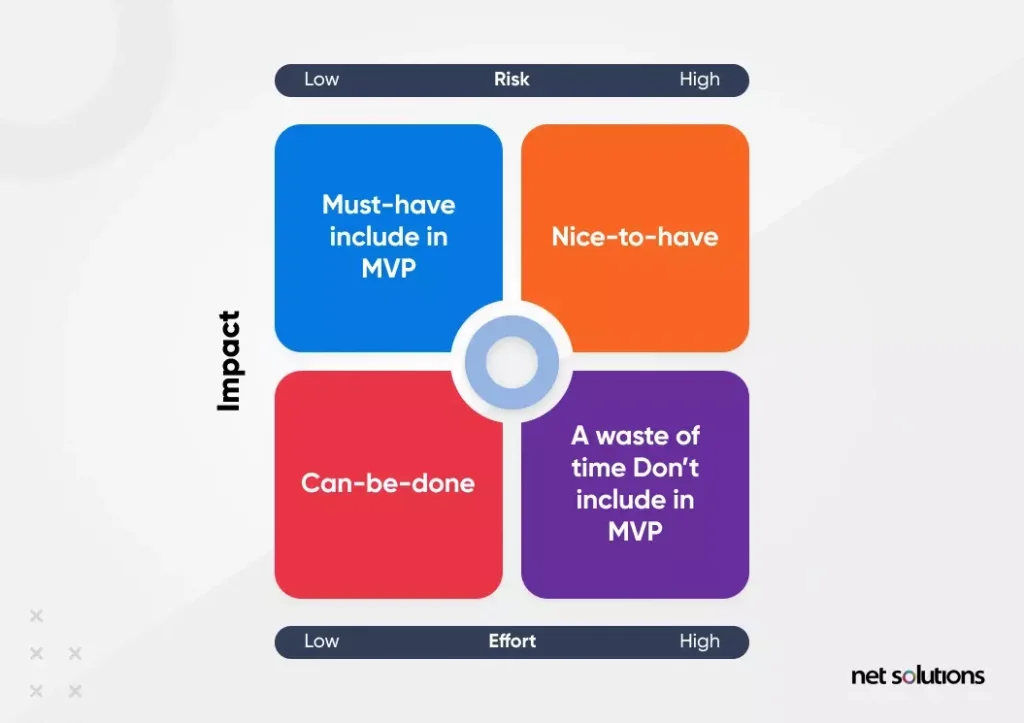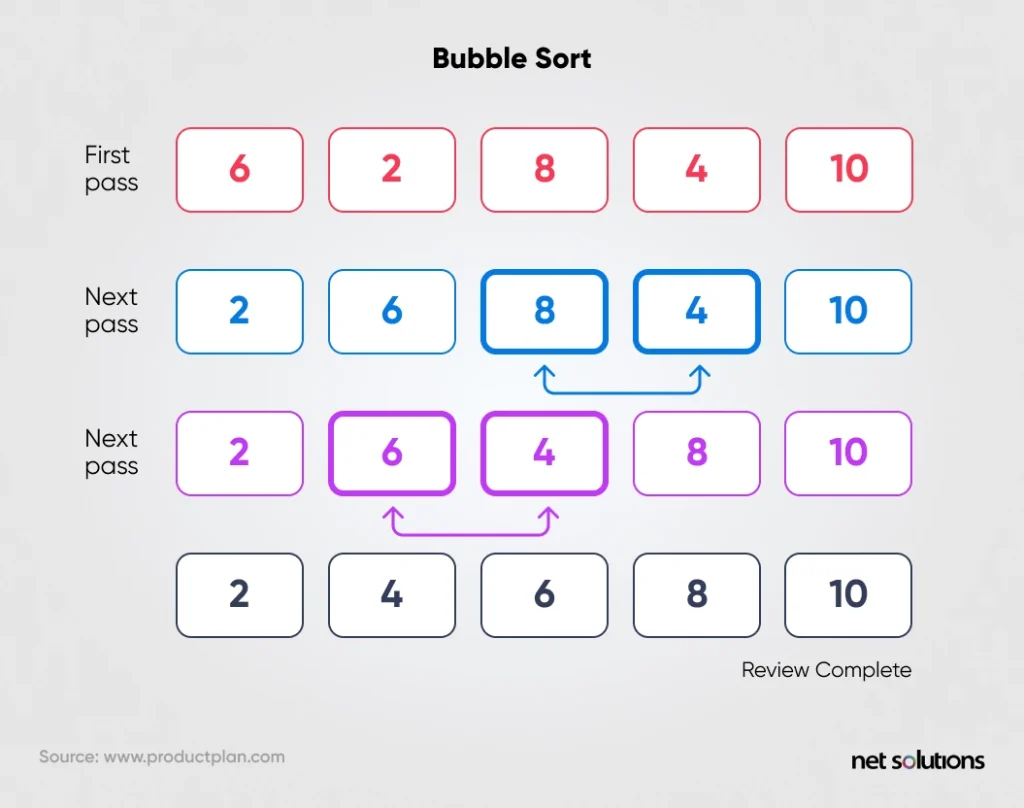When designing and building a Minimum Viable Product (MVP), it’s essential to prioritize the key features that allow your first batch of users to solve the problem you’re designing your app to address. This blog post outlines a strategic approach to feature prioritization for MVP software products.
What Is MVP Feature Prioritization?
MVP feature prioritization is a strategic approach to identifying the essential features to include in a Minimum Viable Product. Feature prioritization should be informed by feedback from your target market and guided by whatever problem you are trying to solve for them. It typically involves a comprehensive review of similar products and carefully considering the essential features to make your first release viable. You must accomplish all this without spending needless time and money developing features that don’t add to your core offering and are likely to change in future app versions based on customer feedback.
How do you define features in an MVP?
Before implementing features in your MVP, you must understand key factors like your target audience, the problem they are trying to solve with your product, and how you can make a software product that differs from your competitors. This requires competitor and customer research and careful analysis of the most impactful features you can offer.
Why Does Feature Prioritization Matter?
The idea behind an MVP is to create an essential offering to gather feedback from that first wave of customers. That feedback will shape future (more developed) product releases, assuming there’s enough interest in the MVP.
Without an intelligent approach to MVP feature prioritization, product teams can waste time developing features that aren’t essential to solving the problem while ignoring those that add the most value.
Identifying Business Goals and Defining Your Product Vision
The following steps will help you understand your business goals and define your product vision.
- Explore Customer Needs: Gather feedback from your target audience and explore potential customer needs and further product development as per those needs.
- Identify the Problem You’re Solving: Every product solves a problem; to succeed, you need to define the problem you hope to solve clearly.
- Identify Your Target Market: Who do you intend to serve? Develop user personas for your target audiences and work to see the world from their perspective.
- Determine Your Value Proposition: What will make your product stand out from your competitors’ products? Most apps compete in a crowded marketplace, and the successful ones double down on the features that make them stand out.
Top 11 MVP Feature Prioritization Models
1. Feature Priority Matrix

Software teams use a feature prioritization matrix to evaluate three factors associated with adding a feature: Impact, Effort, and Risk.
Software teams use a feature prioritization matrix to evaluate three factors associated with adding a feature: Impact, Effort, and Risk.
High-impact/low-effort items are no-brainers, while high-impact/high-effort items may be valuable but require careful planning and analysis.
2. Feature Buckets

Feature buckets are a method of thinking about and categorizing possible features to develop based on their impact on your business. Three common buckets are customer requests, metric movers, and delighters.
- Customer Requests: This feature bucket includes all requests from your customers. It will involve a lot of recommendations you won’t want to implement because they require high effort and will only move the needle for a small group of users. However, some will be true game-changers, so they’re worth considering. When building an MVP, you won’t have customer feedback because you don’t have customers. However, you can learn a lot from talking to and surveying potential customers.
- Metric Movers: Metric movers are those features you believe will result in changes to key metrics, such as improving customer retention (i.e., reducing churn), boosting Customer Satisfaction (CSAT), improving Net Promoter Score (NPS), etc.
- Delighters: This bucket is for features you’ve tried out in focus groups and user testing, and you’ve found that customers love them—even though it’s likely nobody ever requested them. Often they’re novel ideas that few people would think to include, such as Amazon’s Buy Now button. One rogue developer had that idea and tested it out, and it became so successful that Amazon patented it.
3. MoSCoW Matrix
The MoSCoW Matrix is a user-oriented feature prioritization model that breaks possible features into Must-Haves, Should-Haves, Could-Haves, and Will-Not-Haves (for now) categories to cleverly spell out an acronym for the capital of Russia.
- Must-Haves: Critical features that make your MVP viable.
- Should-Haves: Nearly critical features you want to try to include.
- Could-Haves: These features might improve the user experience, but they’re not necessary for the MVP, and most will be saved for later releases if they make sense at that time.
- Will-Not-Haves (for now): These features aren’t necessary for the MVP, and including them would amount to wasted resources.

4. Kano Model
The Kano model for MVP feature prioritization is highly user-oriented. It’s similar to the MoSCoW Matrix in categorizing potential features based on their importance to the user experience. The Kano model uses the following criteria, which group features by how essential they are to the MVP.

- Threshold: Threshold features are the nuts and bolts of your application—the fundamental features that enable and ensure usability.
- Performance: Performance features aren’t necessary, but they significantly improve the user experience.
- Excitement: Excitement features aren’t features that users consider essential or even expect to find in an app like yours, but they have the potential to delight.
5. Relative Weighting Prioritization
Relative weighting is a method that ascribes a numeral value to each feature based on four specific criteria: Benefit, Penalty, Cost, and Risk.
- Benefit: Estimated value that a feature offers prospective users
- Penalty: Estimated negative impact of not adopting the feature
- Risk: Possible challenges designers and developers might face implementing the feature
- Cost: Resources required to implement the feature
The Product development teams ascribe several 1-9 to each category and plug them into the following equation:
Penalty Score + Benefit Score / Risk Score + Cost Score
The final score can be positive or negative, and teams should consider implementing the highest scores.
6. Numerical Assignment (a.k.a. Grouping)
This MVP feature prioritization technique requires teams to group features in terms of value, giving each group a numerical code. For example, high-value features might receive a 1, medium-value features might get a 2, and low-value features might receive a 3.
7. Bubble Sort Method
This technique asks teams to compare two features side-by-side, rank them by priority, briefly explain the ranking, and then compare the winner to the next prospective feature on the list. For example, imagine you’re building a dating app and want to compare three features: Embedded videos, GPS matching, and a questionnaire that matches users based on personality.

Let’s say you first compare embedded video to GPS matching and decide that GPS matching is essential, so people don’t match with someone on the other side of town. Next, you compare GPS matching to the personality questionnaire, and once again, GPS matching wins. Lastly, you compare the embedded video to the questionnaire and decide that video is more important because that’s the feature the market is demanding right now.
Now you’ve got your three top features prioritized: (1) GPS matching, (2) Embedded Video, (3) Personality Questionnaire, with a brief explanation for each ranking.
8. Opportunity Scoring?
Opportunity scoring uses Voice of the Customer (VoC) feedback to have potential users evaluate and rank the features they would like to see in your app. Most of these features will be drawn from similar apps, and users can indicate what they think of them in those competitor apps.
9. Speed Boat Technique
This brainstorming technique is used to identify risks and opportunities when prioritizing MVP features. Teams imagine they’re in a speedboat, trying to get to an island (MVP). They consider anchors that might slow them down (risks) and factors that will help push their boat in the right direction (opportunities). This technique is more abstract and expansive, designed to generate ideas and spark conversation than to develop a linear, ranked list.
10. User Story Mapping
This technique outlines the user journey from the time they download the app through their use of its various features. Drawing from customer journey mapping techniques, user story mapping helps product software teams prioritize MVP features by putting themselves in the customer’s shoes.

How do you prioritize feature requests?
There are several techniques for prioritizing feature requests, and we’ve listed some excellent methods above that will guide you. It’s important to remember that while it may be tempting to prioritize a commonly requested feature, you should still take a reasoned approach when you decide whether to include it in your next release. For example, if a request is popular but extremely high-risk, you must weigh it against its potential impact on your customers.
Select Your MVP Features Carefully
When prioritizing features for your MVP, prioritize your wants over your needs. Focus your User Experience (UX) efforts on the key features that make your app viable and solve genuine customer needs. Also, don’t be afraid to put more time into features that offer long-term value to your customers—the ones that will form the backbone of your application and aren’t likely to be swapped out with newer features down the line.
There’s no “best way” to prioritize features since your approach will depend on your specific MVP strategy. Instead of trying to identify a universally superior technique to all the rest, review the MVP feature prioritization techniques we’ve outlined in this article and determine how well they fit with your budget and capacity.
We should note that some app features require a large user base to work well, so unless features like that are key to your most basic functionality, they should be lower on the priority list. Once your app is up and running, draw from your customer support cases and any customer feedback you receive to prioritize new features for your next release.
Frequently Asked Questions
1. What are the four types of MVPs?
There are different types of MVPs, and four of the most common ones are The Concierge MVP, the Wizard of Oz MVP, the Landing Page MVP, and the Email MVP. Here is a brief explanation of each.
Concierge MVP: This type of MVP has human beings performing tasks that will, in later versions, be performed automatically by your app (assuming the MVP demonstrates the strong demand for the product).
Wizard of Oz MVP: The Wizard of Oz MVP takes the Concierge MVP concept a little further, creating an app that appears to be more advanced than it is—but still relies on the manual work of human beings to make specific tasks possible.
Landing Page MVP: A Landing Page MVP isn’t an MVP; it’s a standalone page describing what your app plans to accomplish once you create it. It’s a great way to gather interest and build a mailing list.
Email MVP: Like the Landing Page MVP, an Email MVP is also not a true MVP. It’s just an email you send prospective customers to gauge their interest.
2. What is a single-feature MVP?
A single-feature MVP tests the viability of a specific feature that, based on your user feedback and research, would improve the user experience. You can use a single-feature MVP to determine the overall viability of your solution. Ultimately, you want to decide whether it will solve a specific problem for your customers.
3. Is an MVP the same as a prototype?
An MVP is typically a fully functional (albeit basic) application, while a prototype is a product simulation. A prototype is used to see how users respond to your design ideas. Prototypes can be high-fidelity or low-fidelity, and you can learn more about prototyping by checking out the blog we wrote on the topic.
4. What does it cost to build an MVP?
Different MVPs have different price tags depending on their planned functionality, so we wrote a blog post on MVP costs (with real-world examples from apps you know and love, like Instagram, WhatsApp, and Twitter). There is a tremendous range of potential expenses, so if you have an MVP in mind, it’s best to speak with an MVP Development Company.
SHARE THIS POST
Table of Contents
Related Resources
- What Is an MVP App? A Guide to Building Successful Products
- A Deep Dive Into 7 Minimum Viable Product Benefits
- A Step-by-Step Guide to Build a Minimum Viable Product (MVP)
- 19-Step Minimum Viable Product (MVP) Checklist [With PDF]
- How Much Does a Minimum Viable Product (MVP) Cost? Here’s the Answer
- 10 Top MVP Development Companies [Great for Startups]
- 10 Minimum Viable Product (MVP) Examples You Should Know
- The Ultimate Guide to Developing an MVP in Agile: What, How, and Why
- A Step-by-Step Guide on how to Master Your MVP Launch in 2025
- How to Test an MVP: 15 Proven Strategies that Work
- 20 Great MVP Tools to Help You Create & Launch Your Product
- 11 different Types of MVPs to Kickstart Your Software Project
- How to Nail MVP Design with UX Design Principles that Work
- MVP Website: Benefits, Best Practices, How to Build & More



